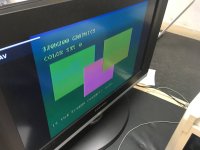I was trying out the composite output (NTSC) of my IBM CGA card and am experiencing color issues. Plain black & white text is OK, but there's no color in text mode and in graphics modes the TV often flickers and fails to sync properly. When it does hold steady, the colors are typical off though occasionally on some screens (usually those that are mostly black or mostly white), the colors looks OK. I read that rotating adjustable capacitor C1 may help, and while some positions seemed a bit better than others, nothing fixed it. Any ideas? Is C1 likely to blame, or might it be an issue with the video card itself?
Upcoming Events:
- VCF South West - June 14 - 16, Davidson-Gundy Alumni Center at University of Texas at Dallas
- VCF West - Aug 2 - 3, Computer History Museum, Mountain View, CA
- VCF Midwest - Sept 7 - 8 2024, Schaumburg, IL
- VCF SoCal - Mid February 2025, Location TBD, Southern CA
- VCF East - April 2025, Infoage Museum, Wall NJ
-
Please review our updated Terms and Rules here
- Forums
- Companies
- IBM Computers, PCs, Clones and Descendants
- PCs and Clones (XT and early AT class machines)
You are using an out of date browser. It may not display this or other websites correctly.
You should upgrade or use an alternative browser.
You should upgrade or use an alternative browser.
CGA Composite Color Issues
- Thread starter PatrickXT
- Start date
reenigne
Veteran Member
The C1 position is fine in c1.JPG. If the image isn't stable with the capacitor in that position there's another problem. It could be an issue with the sync circuitry on your card, but more likely is that the TV you're using is being overly picky about the signal - even when it's working perfectly the CGA card's signal takes some liberties with the NTSC specification. Do you have another composite monitor that you could try? There is also such a thing as a device for conditioning a composite signal which might help.
I tried a different TV, and this one is better, no sync issues. Color was absent sometimes, particularly in 80-column text mode. I downloaded the 8088 MPH demo it started up in black and white, but adjusting the hsync/phase values at the settings prompt resulted in color. I also came across TVCGAFIX Utilities and was able to get color in 80-column text mode using it. So while it does seem composite CGA is quite finicky, if that's to be expected then everything appears to be working properly.
Attachments
reenigne
Veteran Member
Yes, it's expected to not get colour by default in 80-column text mode - there's a design flaw with the CGA card that suppresses the color burst in this mode (and IBM didn't bother to fix it since colour text is not very legible in 80-column mode).
That sounds very intended and not like a bug.Yes, it's expected to not get colour by default in 80-column text mode - there's a design flaw with the CGA card that suppresses the color burst in this mode
reenigne
Veteran Member
No, it's really a bug because it also slightly truncates the horizontal sync pulse, taking it further from NTSC specifications (though the shortened pulse still works fine with CRT monitors). There's also no need for it, since there is a separate +BW bit to eliminate the color burst to make 80 column text legible (which also turns off the color carrier, which is the more important factor in legibility).
Eudimorphodon
Veteran Member
There's also no need for it, since there is a separate +BW bit to eliminate the color burst to make 80 column text legible (which also turns off the color carrier, which is the more important factor in legibility).
Anyone who’s ever hooked up a monochrome composite monitor knows that, yeah, unless you turn off the color carrier the output is terrible, the color info shows as vertical pinstripes completely tearing apart the underlying gray characters.
That shortened sync pulse is almost certainly just a bug, I would guess (without looking at the schematic) that they derived the length of the sync pulse from the character/attribute cell timing chain, which effectively runs twice as fast in the 80 column text mode than it does in any other mode and didn’t compensate. FWIW, in my limited experience (been a long time since I had a real IBM CGA card) some monitors displayed color text anyway; I had a 5150 hooked to a color TV through a VCR once and the text was in color; completely unreadable, but color.
reenigne
Veteran Member
That's exactly the bug.
Yes, I noticed a few monitors/TVs get confused by the lack of a color burst. Not disabling colour (and getting random animated rainbows as a result) is one of them. Another is the gain being set to normalise the burst amplitude, which (with no burst to amplify) results in the gain being turned way up and getting a very bright, washed out image. Sometimes both of these at once.
Yes, I noticed a few monitors/TVs get confused by the lack of a color burst. Not disabling colour (and getting random animated rainbows as a result) is one of them. Another is the gain being set to normalise the burst amplitude, which (with no burst to amplify) results in the gain being turned way up and getting a very bright, washed out image. Sometimes both of these at once.







